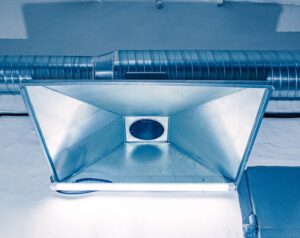A well-designed local industrial exhaust system can effectively control harmful fumes, dust, and other airborne hazards. Unlike general ventilation, which circulates air throughout a space, local exhaust ventilation targets specific contaminants at their source. This direct approach is crucial for protecting worker health and complying with safety regulations.
Today, we will discuss the key components of a local exhaust system and compare local systems to larger setups. Proper ventilation is essential for almost every type of industrial setting, and we can help pinpoint your precise exhaust and ventilation needs. At Eldridge, our technical team is experienced in assessing and designing industrial exhaust systems based on the type of operation and size of facility. Contact us for a consultation and quote today.
Local Industrial Exhaust System Components

A local exhaust system creates a controlled airflow at the source of the contaminant to prevent pollutants from spreading. It uses a number of core components that work together to achieve this.
Hoods or dust collectors: These are the capture devices that enclose or partially enclose the contaminant source. Hood types vary based on the application, from simple enclosures to complex capture arms.
Ducts: These channels transport the contaminated air from the hood to the air cleaning device or directly to the exhaust fan. Ducts should be airtight to prevent leakage and maintain airflow.
Fans: The heart of the system, fans create the necessary airflow to move contaminated air through the ducts. Fan selection depends on factors like airflow requirements, pressure, and noise levels.
Air cleaning devices: These components remove contaminants from the airflow before it’s released into the atmosphere. Options include filters, scrubbers, and electrostatic precipitators, chosen based on the type of contaminant.
Exhaust stacks: The final component, exhaust stacks release cleaned air into the atmosphere at a safe distance from the building.
Local vs. Larger Industrial Exhaust Systems
Understanding the differences between local and larger industrial exhaust systems is crucial for selecting the right solution for your workplace.
A local system excels at controlling specific contaminants at their source. It’s ideal for processes generating high concentrations of harmful substances or when worker exposure is a primary concern. They are often more energy-efficient as they focus on a specific area rather than diluting contaminants throughout a large space.
Larger, integrated industrial exhaust systems are typically used for general ventilation and climate control. They can help reduce overall contaminant levels but may not be as effective at controlling specific hazards. These systems are often necessary in large industrial facilities where temperature and humidity control are essential.
When deciding between the two, consider the following factors:
- Type and quantity of contaminants: If you’re dealing with high concentrations of hazardous substances, local exhaust is the preferred choice. For lower levels of contaminants and general air quality improvement, a larger system might suffice.
- Process and workspace layout: Smaller and targeted exhaust setups are ideal for localized processes, while larger systems are better suited for open spaces.
- Cost and energy efficiency: Local systems are generally more cost-effective to operate due to their targeted approach.
- Regulatory compliance: Both local and larger systems must comply with safety regulations, but the specific requirements may vary.
In many cases, a combination of local and larger exhaust systems can provide optimal protection. By using both systems, you achieve a layered approach to safety. A local exhaust setup handles critical exposure points, while the facility industrial ventilation system maintains a healthier atmosphere overall. This approach allows for customization based on specific needs. You can focus both directly on high-risk areas and use a larger system for general air exchange simultaneously.
Effective Design for an Industrial Exhaust System
Designing the most efficient and effective ventilation system requires expertise to ensure optimal performance and safety. First, the characteristics of the contaminant need to be assessed. The type, concentration, and physical properties of the contaminant will determine the appropriate hood design, duct material, and air cleaning device.
Next, we need to determine the airflow requirements, as proper airflow is critical for capturing and transporting contaminants. Factors such as hood capture velocity, duct size, and fan performance must be carefully calculated.
If a specific noise threshold needs to be maintained in the facility, that needs to be integrated into the design. Exhaust systems can generate extra noise, so it’s important to select quiet components and implement additional noise reduction measures where necessary.
The design should ensure easy access to components for maintenance, as regular inspection and cleaning are essential for maintaining your system efficiency. It should also adhere to all applicable safety and environmental regulations. This may involve specific requirements for hood design, air cleaning, and exhaust emissions.
Experts in Assessment and Design for Industrial Exhaust Systems
A well-designed industrial exhaust system is indispensable for protecting your employees’ health and optimizing the workplace. Invest in a professional ventilation system design with our team at Eldridge. Our experts can assess your specific needs, develop a tailored solution, and help you stay compliant with all relevant regulations regarding ventilation. Contact us today to schedule an assessment of your industrial ventilation setup.
